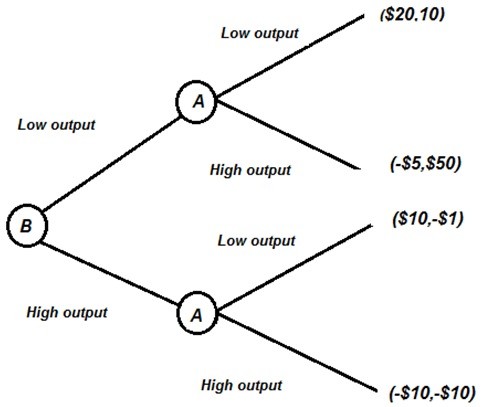Using the following sequential-move production game, determine whether player B has a first-mover advantage and identify the strategy that leads to that advantage: 
A. Player B has a first-mover advantage. The equilibrium strategies leading to an advantage are {(low output); (if low output, high output), (if high output, high output)}.
B. Player B has a first-mover advantage. The equilibrium strategies leading to an advantage are {(high output); (if low output, high output), (if high output, low output)}.
C. Player B has a first-mover advantage. The equilibrium strategies leading to an advantage are {(low output); (if low output, high output), (if high output, low output)}.
D. Player B does not have a first-mover advantage in the game.
Answer: B
You might also like to view...
If the income per capita of United Kingdom is £23,800 and dollar/pound exchange rate (US$/£) is 1.68 in 2014, the income per capita of UK in US dollars in the same year is ________
A) $30,400 B) $22,829 C) $12,812 D) $39,984
Under Federal Trade Commission merger guidelines, an industry with a Herfindahl-Hirschman index (HHI) of 800 points is considered
A) competitive. B) moderately concentrated. C) concentrated. D) a monopoly.
Which of the following would be the best example of an oligopolistic industry?
A) agriculture B) large aircraft manufacturing C) confections D) retail convenience stores
If velocity remains constant, which of the following examples would cause the price level to be stable?
a. Money supply increases by 7 percent; real GDP increases by 8 percent. b. Money supply increases by 8 percent; real GDP increases by 11 percent. c. Money supply increases by 5 percent; real GDP increases by 3 percent. d. Money supply increases by 12 percent; real GDP increases by 12 percent.